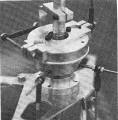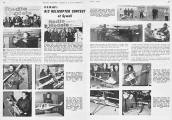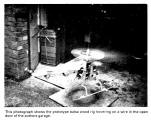John Drake (UK)
John Drake Hiller Raven UH-12E (1973)
In the UK John Drake, an Engineer and Modeller had been experimenting to get an idea of power requirements etc and following on from this had built a rig to put them into practice. Like Dieter, he had a 'need' to do something different with an introduction below in his own words from the book release in 1977:
MY INTEREST in Helicopters goes back more years than I care to remember. Even when I was in my early teens I made a rubber powered autogyro. Although this would autorotate quite readily when dropped from a bedroom window it would persist in rolling over with any attempt at horizontal flight. At that tender age I was baffled by the model's behaviour but that experience has haunted me ever since. Although I have been an ardent aeromodeller ever since my school days I have had a yearning to tackle a mechanical project such as a model locomotive. The idea of a helicopter provided the challenge which happily combined both aeromodelling and machining interests.
I remember attending a lecture on full sized helicopter development where the speaker's opening remarks were: 'A Helicopter is a mechanical engineer's dream but an aerodynamicist's nightmare'
Need I say more??
I have combined both theory and practical experience which has resulted in a successful home-built helicopter (Note - early 70's).
I should say at the outset that most model aircraft design is based on, "if it looks right it is right". This philosophy is fine but it is really the result of what we have been accustomed to seeing. However, when there isn't any experience on which to base our seeing judgement, it is better to do a few sums then carry out an experiment to verify the calculations rather than to make a large number of fruitless tests not really understanding the problem.
John Drake carried out a number of experiments with electric drills and rotors to determine lift from various blades etc and then designed himself a test rig. This allowed him to concentrate on head design, lift and tail balance before having to focus on the head control.
His first rotor head incorporated flapping hinges, lead - lag, etc just like all the books said was required. It was though unstable with the blades 'flapping' up and down in an uncontrolled manner due to ground effect. He then carried out more research and came upon the 'Hiller' control system as noted for 'small' helicopters; though small meant the authors original prototypes which whilst not being 'model' small would perhaps be more suitable. By early 1972 the test rig had been 'flown' numerous times and all the calculations and theories proved so it was time to move on.


With this working control system it was considered fitting that the next model would be a scale version of Hiller's helicopter the UH-12E. This was duly designed, built and tested by Roy Sturman who was another well known modeller who then went on from this experience went on to design a successful RC autogyro in the late 70's based on the Wallis "Little Nell" of James Bond fame; this was subsequently marketed by Micro-Mold.





close-up detail of the UH-12E.
 First UK helicopter competition.
First UK helicopter competition.


